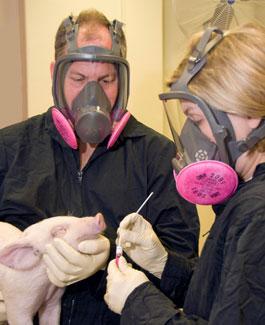Global swine trade facilitates evolution, spread of flu
March / April 2015 | Volume 14, Issue 2

Photo courtesy of USDA/ARS
Global trade of live pigs increases the risk of an
influenza pandemic, research shows.
Live pigs are transported between many parts of the world, spreading the influenza viruses they carry, and allowing them to mix and evolve in ways that could produce another influenza pandemic. To prepare against future outbreaks in humans, countries must step up swine surveillance and encourage vaccination of swine workers, according to recent studies.
In
research published in
Nature Communications, Fogarty scientists Drs. Martha Nelson and Cecile Viboud and their international collaborators investigated how swine trade can spur the evolution of influenza, including the 2009 H1N1 pandemic.
"The central question is how a flu virus jumps from animals to humans, and we understand so little," Nelson said. "We must gain more understanding of viral evolution in animal hosts or we’re going to be just as flat-footed when the next pandemic occurs." In the 2009 pandemic, the influenza virus transmitted from swine to people, with the first human outbreak in Mexico. "But we have no idea where that virus evolved undetected in pigs for many years or how it got to Mexico."
In their study, the largest of its kind to date, the team analyzed live pig trade data from 146 countries and whole-genome swine influenza sequences from 10 countries. Viral movements correlated strongly with trade patterns. Europe and North America - major swine exporters - were the main sources of viruses found in Asian countries, but a surprising discovery was that China had very little influence on its neighbors, largely because it keeps most of its farm-raised pigs for the large domestic market. Surveillance data were very limited in many places that import pigs from different continents and are likely to be mixing grounds for viral evolution, including Russia and Southeast Asia.
Despite trade’s role in fueling the risk of pandemics, Nelson acknowledged that limiting such live pig movements - except perhaps quarantining noticeably sick pigs - would be impractical and not necessarily prevent outbreaks because of the ease with which humans can infect pigs. Human-to-pig transmission of influenza is the topic of another paper by Nelson, co-authored by Dr. Amy Vincent of the U.S. Department of Agriculture (USDA), and
recently published in
Trends in Microbiology. Their review highlighted the surprising frequency with which humans infect swine with influenza viruses, far more than the other way around.
The circulation of human influenza viruses in pigs is likely to contribute to the next pandemic. Genetic research is revealing the extent to which influenza viruses can reassort in pigs by exchanging RNA. The H1N1 pandemic virus was a reassortant, with gene segments from North America and Eurasia. "Reassortment allows the virus to evolve rapidly and unexpectedly, and to overcome evolutionary hurdles that might be impossible through simple mutation," Nelson said. "It can make big leaps in mutational space."
Nelson and Vincent urged more attention be paid to the human-pig pathway, for instance by enhancing vaccine strategies in swine workers, learning more about the mechanisms enabling the virus to move between the two species, and further expanding global surveillance of the influenza virus in pigs.
Although pig surveillance has picked up around the world since the 2009 pandemic, the animals receive much less attention than birds, another particularly accommodating host for influenza genetic diversity and reassortment. Bird deaths spark media headlines, intense surveillance and prophylactic killings, but while sick pigs may lose weight, they typically stay alive. "You can have viruses lurking in pigs that might be more dangerous to humans, but we’re not detecting them, they’re not in the news," Nelson said. "In some ways, the pig viruses may be even more dangerous because they’d be silent threats."
More Information
To view Adobe PDF files,
download current, free accessible plug-ins from Adobe's website.